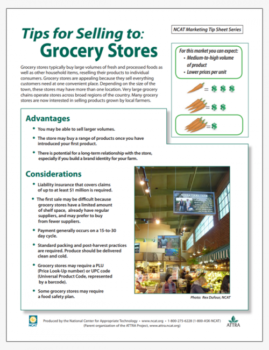Tips for Selling to Grocery Stores
By Marisa Alcorta, Rex Dufour, and Tammy Hinman, NCAT Agriculture Specialists
NCAT Marketing Tip Sheet Series
Grocery stores typically buy large volumes of fresh and processed foods as well as other household items, reselling their products to individual consumers. Grocery stores are appealing because they sell everything customers need at one convenient place. Depending on the size of the town, these stores may have more than one location. Very large grocery chains operate stores across broad regions of the country. Many grocery stores are now interested in selling products grown by local farmers.
Advantages
- You may be able to sell larger volumes.
- The store may buy a range of products once you have introduced your first product.
- There is potential for a long-term relationship with the store, especially if you build a brand identity for your farm.
Considerations
- Liability insurance that covers claims of up to at least $1 million is required.
- The first sale may be difficult because grocery stores have a limited amount of shelf space, already have regular suppliers, and may prefer to buy from fewer suppliers.
- Payment generally occurs on a 15- to 30-day cycle.
- Standard packing and post-harvest practices are required. Produce should be delivered clean and cold.
- Grocery stores may require a PLU (Price Look-Up number) or UPC code (Universal Product Code, represented by a barcode).
- Some grocery stores may require a food safety plan.
Tips for Selling to Grocery Stores
- Be professional, reliable, and on time when communicating and delivering products.
Visit or call the store and ask for an appointment with the produce buyer before the season begins. - Bring your crop plan or product list for the full season, and a price list. Show visuals for the upcoming crops — photos of trees in bloom, what the fruit looks like, testimonials, brix readings. If you have something to sample, bring it to show your quality and pack.
- Always bring two copies of an invoice, one for your customer and one for you. Both copies should be signed at the time of delivery, providing proof that quality and quantity are accurate.
- Build relationships with everyone who handles your product.
- Ask about and follow the store’s expectations for pack, size, grade, or post-harvest practices.
- Communicate with buyers often throughout the course of the week to keep them updated on your product quality and quantity.
- Plan your plantings for continuous harvest and adequate volume to supply expected demand from store.
- Get the store’s produce team enamored with your farm by educating them about your products. Give them samples to take home and maybe provide recipes.
- Offer to provide farm tours, pictures of your farm for display, and in-store demos of your products with
recipes and descriptions.
Key Questions to Ask Yourself
- What products do local grocery stores want that I could supply, including specialty ethnic foods?
- Does a particular chain have an interest in purchasing locally?
- What is my plan to ensure a consistent supply of a few key products over a period of several weeks?
- Do I have a Good Agricultural Practices (GAPs) plan? Does this buyer require it?
Further Resources
ATTRA Publication Library
Browse ATTRA’s library of trusted and practical publications on everything from regenerative grazing and soil health, to crop production and marketing. All publications are free and available as a digital download or audio reader.
- See advertised prices of last week’s produce nationwide and by region at USDA’s Market News.
- Price Look-up numbers (PLUs): a complete list is available at plufinder.com.
- Rodale Institute Organic Price Report shows prices of fruit, vegetables and grains for six different wholesale terminals across the U.S.
- This Wall Street Journal article explains why and how to obtain UPC codes, including costs and alternatives.
Tips for Selling to: Grocery Stores
By Marisa Alcorta, Rex Dufour and Tammy Hinman, NCAT Agriculture Specialists
© 2012 NCAT
IP424
This publication is produced by the National Center for Appropriate Technology through the ATTRA Sustainable Agriculture program, under a cooperative agreement with USDA Rural Development. This tipsheet was also developed with assistance from Dina Izzo, Bludog Organic Produce Services. The development of this material was supported through USDA/NIFA/OASDFR.


